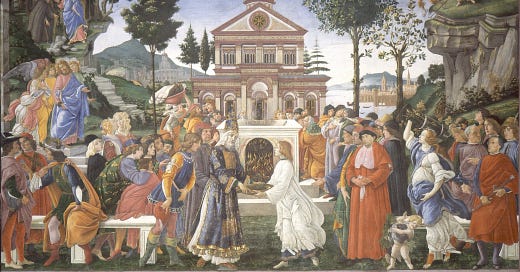First Sunday in Lent
Oratio, Visio Divina, and Crumbs from our Master's Table. Plus, Should Protestants Observe Lent?
Oratio
“But I discipline my body and keep it under control, lest after preaching to others I myself should be disqualified.” -1 Corinthians 9:27
O Lord, who for our sake did fast forty days and forty nights: give us grace to use such Abstinence that our flesh being subdued to the spirit, we may ever obey thy godly motions in righteousness, and true holiness, to thy honor and glory who lives and reigns with the Father and the holy Ghost, one God, world without end. Amen.1
Visio Divina
Visio Divina is a way of entering our prayer closet through sensible perception.
The painting’s description from The Artistic Adventure of Mankind.
The theme of these fresco decoration was a parallel between the Stories of Moses (see picture above) and those of Christ, as a sign of continuity between the Old and the New Testament. This fresco depicts three episodes from the gospels, in parallel with the painting on the opposite wall, showing the Trials of Moses. This fresco though, on the contrary, is read from left to right: on the top left corner, Jesus, who has been fasting, is tempted by the Devil, in the guise of a hermit, to turn stones into bread. In the second scene of temptation, at the upper center of the picture, the Devil has carried Jesus to the top of the temple of Jerusalem, represented by the façade of the Chapel of Santa Maria in Traspontina of the Church of Santo Spirito in Sassia in Rome. The Devil tempts Jesus to challenge God’s promise that he will be protected by angels, by throwing himself down. In the third temptation, to the upper right, the Devil has taken Jesus to a high mountain where he shows him the beauties of the Earth. The Devil promises Jesus power over this domain, if he will deny God and bow down to the Devil. Jesus sends the Devil away from him, while angels come to minister to him. In the foreground, a man whom Jesus has healed of leprosy presents himself to the High Priest at the temple, so that he may be pronounced clean. The young man carries a basin of water, in which is a bough of hyssop. A woman brings two fowls for sacrifice (middle center left) and another woman brings cedar wood (to the right). These three ingredients were part of the ritual of cleansing of a leper. The high priest may symbolize Moses, who transmitted the Law, and the young man may symbolically represent Christ, who, according to the Gospels, was wounded and slain for the benefit of mankind, and healed through the Resurrection so that mankind might also be made spiritually clean, and receive salvation.
Crumbs From Our Master’s Table
The Book of Common Prayer from the Original Manuscript: Attached to the Act of Uniformity of 1662 (London; Edinburgh; Glasgow; Melbourne; Sydney; New York: Eyre & Spottiswoode, 1892), 116.






